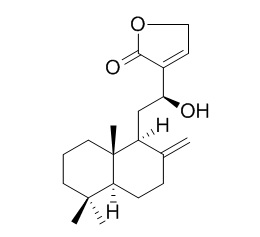Vitexolide D
Vitexolide D shows moderate antibacterial activity against a panel of 46 Gram-positive strains. It also shows cytotoxic activities against the HCT-116 cancer cell line and human fetal lung fibroblast MRC5 cell line (1 < IC50s < 10 uM).
Inquire / Order:
manager@chemfaces.com
Technical Inquiries:
service@chemfaces.com
Tel:
+86-27-84237783
Fax:
+86-27-84254680
Address:
1 Building, No. 83, CheCheng Rd., Wuhan Economic and Technological Development Zone, Wuhan, Hubei 430056, PRC
Providing storage is as stated on the product vial and the vial is kept tightly sealed, the product can be stored for up to
24 months(2-8C).
Wherever possible, you should prepare and use solutions on the same day. However, if you need to make up stock solutions in advance, we recommend that you store the solution as aliquots in tightly sealed vials at -20C. Generally, these will be useable for up to two weeks. Before use, and prior to opening the vial we recommend that you allow your product to equilibrate to room temperature for at least 1 hour.
Need more advice on solubility, usage and handling? Please email to: service@chemfaces.com
The packaging of the product may have turned upside down during transportation, resulting in the natural compounds adhering to the neck or cap of the vial. take the vial out of its packaging and gently shake to let the compounds fall to the bottom of the vial. for liquid products, centrifuge at 200-500 RPM to gather the liquid at the bottom of the vial. try to avoid loss or contamination during handling.
Int J Pharm.2022, 618:121636.
Natural Product Sciences2023, 29(4):276-280.
Pharmacognosy Journal2019, 11,6:1235-1241
Planta Med.2023, 2192-2281
Molecules.2017, 22(3)
Microchemical Journal2024: 196:109676.
J Appl Biol Chem.2021, 64(3),263?268
Nature Ecology & Evolution2020, doi: 10.1038
FASEB J.2019, 33(8):9685-9694
Nutrients.2018, 10(10)
Related and Featured Products
J Nat Prod. 2015 Jun 26;78(6):1348-56.
Antibacterial Labdane Diterpenoids from Vitex vestita.[Pubmed:
26034885 ]
METHODS AND RESULTS:
Bioassay-guided purification of the dichloromethane extract of the leaves of the Malaysian species Vitex vestita, led to the isolation of six new labdane-type diterpenoids, namely, 12-epivitexolide A (2), vitexolides B and C (3 and 4), vitexolide E (8), and vitexolins A and B (5 and 6), along with six known compounds, vitexolide A (1) and Vitexolide D (7), acuminolide (9), 3β-hydroxyanticopalic acid (10), 8α-hydroxyanticopalic acid (11), and 6α-hydroxyanticopalic acid (12). Their structures were elucidated on the basis of 1D and 2D NMR analyses and HRMS experiments. Both variable-temperature NMR spectroscopic studies and chemical modifications were performed to investigate the dynamic epimerization of the γ-hydroxybutenolide moiety of compounds 1-4. Compounds were assayed against a panel of 46 Gram-positive strains.
CONCLUSIONS:
Vitexolide A (1) exhibited the most potent antibacterial activity with minimal inhibitory concentration values ranging from 6 to 96 μM, whereas compounds 2 and 6-9 showed moderate antibacterial activity. The presence of a β-hydroxyalkyl-γ-hydroxybutenolide subunit contributed significantly to antibacterial activity. Compounds 1-4 and 6-9 showed cytotoxic activities against the HCT-116 cancer cell line (1 < IC50s < 10 μM) and human fetal lung fibroblast MRC5 cell line (1 < IC50s < 10 μM for compounds 1, 2, 7, 8, and 9).



